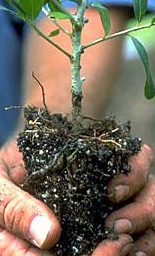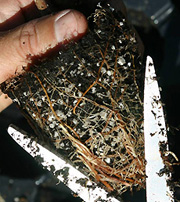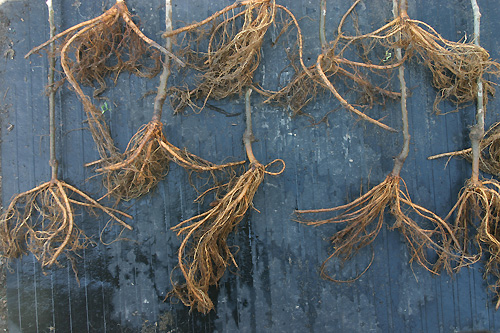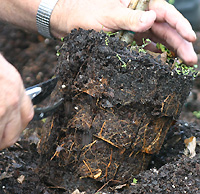Home > Nursery tree production > Root system > Planting liners
Planting liners in field or containers
Young trees in a nursery can be planted from liners of various sizes produced in a variety of manners. It is important to position the top most root close to the soil or substrate surface (see right photo).
Roots should be spread out in a radial manner so root tips are pointed away from the trunk. This allows new root growth to develop  out into the soil or substrate of the larger container. Remove roots growing along the periphery of a container root ball with a sharp scissors type tool such as a desk-top scissors (left photo). This will help ensure that new roots grow away from the trunk.
out into the soil or substrate of the larger container. Remove roots growing along the periphery of a container root ball with a sharp scissors type tool such as a desk-top scissors (left photo). This will help ensure that new roots grow away from the trunk.
Be sure to remove all roots growing up toward the surface since these can develop into serious root defects that can shorten the life of the tree. (below, right photo).
Root systems on bare root trees should be spread out so roots are not growing parallel to each other (below left photo). Roots should not be crossed over each other, and all quadrants should have main roots. Bare root trees can come in a variety of shapes and quality depending on many factors including grower practices, soil type, species, irrigation practices, and other factors. Even root  systems on individuals from the same field can have very different root systems (photo below) , so personnel training is important to ensure quality. Trees can be staked with little negative impact on caliper growth provided low branches are managed correctly.
systems on individuals from the same field can have very different root systems (photo below) , so personnel training is important to ensure quality. Trees can be staked with little negative impact on caliper growth provided low branches are managed correctly.

 Trees from the same field can have very different root systems as shown above. Staff should be trained to distribute roots radially when planting these liners..
Trees from the same field can have very different root systems as shown above. Staff should be trained to distribute roots radially when planting these liners..
Root balls on trees planted from larger containers such as one to seven gallon should be pruned at planting to remove defects on the periphery (see right photo). This can be accomplished by shaving or slicing (See: shaving and slicing). Also check for and remove defects such as roots growing tangent to the trunk on top of the root ball.

